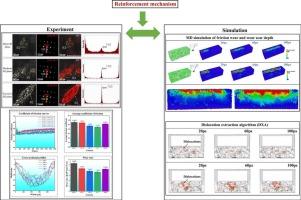Synergistic strengthening through moderate B2 phase and smallest grain size for enhanced wear resistance in Ti2Zr0.75NbVAlx lightweight refractory high-entropy alloys
IF 4.6
2区 材料科学
Q2 MATERIALS SCIENCE, MULTIDISCIPLINARY
International Journal of Refractory Metals & Hard Materials
Pub Date : 2025-08-31
DOI:10.1016/j.ijrmhm.2025.107414
引用次数: 0
Abstract
In this study, we systematically investigate the synergistic effect of B2 phase content and grain size on the friction and wear performance of Ti2Zr0.75NbVAlx (x = 0.1, 0.3, 0.5, 0.7, 0.9) lightweight refractory high-entropy alloys (LRHEAs). Microstructural characterization reveals that the Al0.7 alloy exhibits a moderate B2 phase fraction and the smallest grain size (236.82 μm), leading to superior wear resistance compared to alloys with either minor or excessive B2 phase content (Al0.7 alloy wear rate: 3.6358 × 10−4 mm3/N·m). Molecular dynamics (MD) simulations demonstrate that the combination of a moderate B2 phase and fine grained structure effectively suppresses dislocation multiplication and propagation during friction, minimizing surface damage. The enhanced performance of the Al0.7 alloy is attributed to the synergistic strengthening mechanism: the ordered B2 phase impedes dislocation multiplication, while high-density grain boundaries further restrict dislocation mobility. These findings provide critical insights into the design of advanced wear-resistant LRHEAs by optimizing phase composition and grain refinement, offering a promising pathway for developing high-performance structural materials.

Ti2Zr0.75NbVAlx轻质难熔高熵合金通过中等B2相和最小晶粒尺寸的协同强化增强耐磨性
在本研究中,我们系统地研究了B2相含量和晶粒尺寸对Ti2Zr0.75NbVAlx (x = 0.1, 0.3, 0.5, 0.7, 0.9)轻质耐火高熵合金(LRHEAs)摩擦磨损性能的协同效应。显微组织表征表明,Al0.7合金具有中等的B2相分数和最小的晶粒尺寸(236.82 μm),与B2相含量较少或过多的合金相比,具有更高的耐磨性(Al0.7合金的磨损率为3.6358 × 10−4 mm3/N·m)。分子动力学(MD)模拟表明,适度的B2相和细晶组织的结合有效地抑制了摩擦过程中位错的增殖和扩展,使表面损伤最小化。Al0.7合金的性能增强归因于协同强化机制:有序的B2相阻碍了位错的增殖,而高密度的晶界进一步限制了位错的迁移。这些发现为通过优化相组成和晶粒细化来设计先进的耐磨LRHEAs提供了重要的见解,为开发高性能结构材料提供了一条有希望的途径。
本文章由计算机程序翻译,如有差异,请以英文原文为准。
求助全文
约1分钟内获得全文
求助全文
来源期刊
CiteScore
7.00
自引率
13.90%
发文量
236
审稿时长
35 days
期刊介绍:
The International Journal of Refractory Metals and Hard Materials (IJRMHM) publishes original research articles concerned with all aspects of refractory metals and hard materials. Refractory metals are defined as metals with melting points higher than 1800 °C. These are tungsten, molybdenum, chromium, tantalum, niobium, hafnium, and rhenium, as well as many compounds and alloys based thereupon. Hard materials that are included in the scope of this journal are defined as materials with hardness values higher than 1000 kg/mm2, primarily intended for applications as manufacturing tools or wear resistant components in mechanical systems. Thus they encompass carbides, nitrides and borides of metals, and related compounds. A special focus of this journal is put on the family of hardmetals, which is also known as cemented tungsten carbide, and cermets which are based on titanium carbide and carbonitrides with or without a metal binder. Ceramics and superhard materials including diamond and cubic boron nitride may also be accepted provided the subject material is presented as hard materials as defined above.

 求助内容:
求助内容: 应助结果提醒方式:
应助结果提醒方式:


